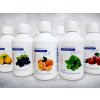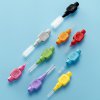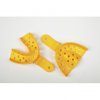Boston is a light cured micro-hybrid composite with increased mechanical strength that provides the dentist with particular comfort in temporary and permanent prosthetic work.
The specially developed composition of the composite guarantees the in-office fabrication of crowns and bridges of exceptional durability.
The carefully selected filler system ensures perfectly smooth surfaces after polymerisation.
Prepared for use as a complete product or together with pre-impregnated polyaramide fibres, additionally the use of Boston Glaze gives the work an excellent cosmetic effect.
Available in shades: A1, A2, A3, A3.5, OA2, OA3, B1, B2, C2, D2, D3, T (Transparent).
Product available in syringes containing 6 g of preparation.
Packages:
1 x 6 g
| Category: | Light-curing |
|---|
Properties:
- Medical device class IIa.
- A polymer dental material type 1 (class 2, group 1).
- Meets the requirements of the ISO 4049 standard.
- Undergoes free radical polymerisation activated by visible light from the blue region (400-500 nm).
- Has a radio-opacity equivalent to approx. 5 mm of aluminium (aluminium has a radio-opacity equivalent to that of dentine; thus 1 mm of material having a radio-opacity equivalent to 1 mm of aluminium has a radio-opacity equivalent to that of dentine and 2 mm of aluminium is equivalent to enamel).
Indications for use:
- Black’s class I, II, III, IV and V cavities.
- Permanent restorations using polyaramid and polyethylene fibre supports: crowns, endocrowns, bridges, inlay/onlay procedures.
- Temporary crowns and bridges.
- Dental splints, permanent – external or internal layer.
- Dental splints, temporary – external layer.
- Composite and acrylic prosthetic restoration repairs
Method of use:
1. For fillings, choose the right shade from the Create composite shade guide before starting the treatment when the tooth is naturally moisturised.
2. Clean and prepare teeth in the normal way.
3. Wherever it is necessary, etch the surface using Etchgel, rinse and dry gently.
4. Apply a bonding system. Create can be used with any standard, light cured, dimethacrylate resin-based bonding systems. A bonding system should be applied in accordance with the manufacturer’s instructions.
5. Open the syringe by uncapping the top of the syringe and draw up the material with the cap or, if necessary, by turning the syringe plunger clockwise - extrude the desired amount of material onto the mixing block.
Always protect the unused portion of material from light. Close the syringe immediately after use.
6. Fill the cavity in layers according to the rules of the art, exposing each layer according to the polymerisation table.

7. Fit the work to the bite.














